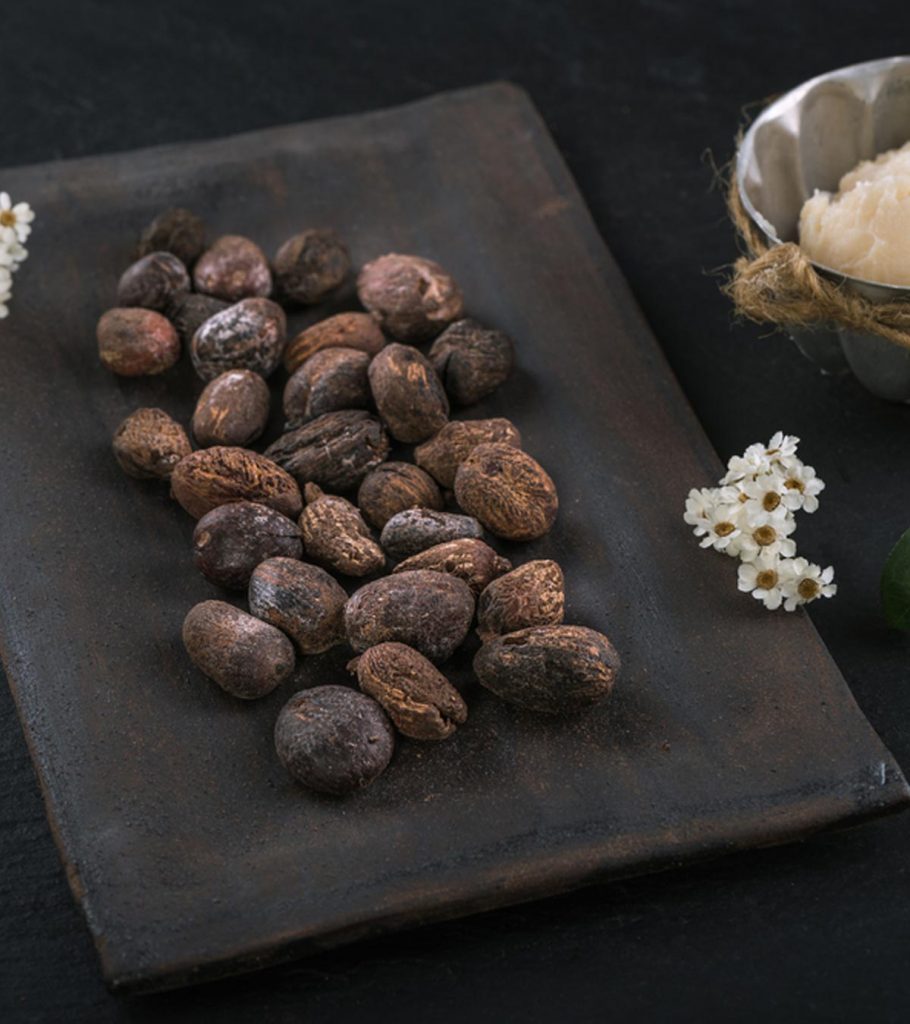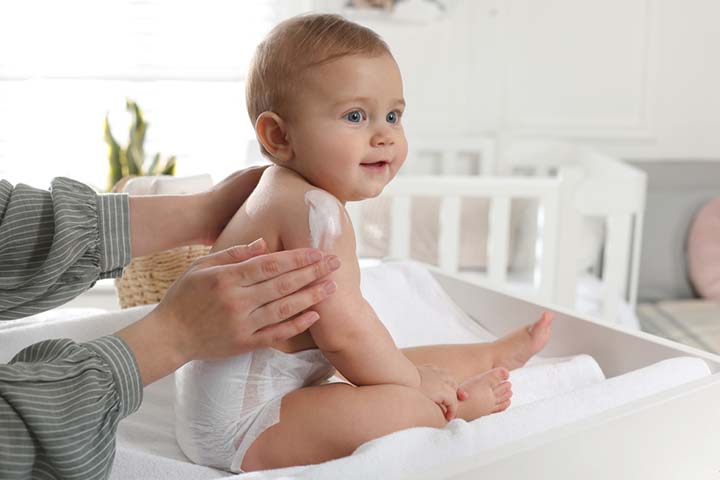Shea butter is a plant-based fat derived from shea nuts. It is widely used in the haircare, skincare, and cosmetic industries. You may consider shea butter for babies if you are exploring natural, plant-based moisturizers.
The butter has a mild, nut-like aroma and is considered to be an effective emollient with anti-inflammatory properties (1). However, since it is derived from a tree nut, you need to stay alert to any allergic reactions.
Read on to know the various uses and benefits of shea butter and the precautions to consider when using it for babies.
Is Shea Butter Safe For Babies?
Shea butter is considered safe for topical use in babies. This natural skincare product is primarily made up of saturated fatty acids like palmitic, stearic, oleic, linoleic acid, and arachidonic acid (2). It is considered a wonderful moisturizer for dry skin.
The linoleic acid is an essential fatty acid considered vital for health. Besides, the butter contains vitamin E that is good for the skin.
Raw shea butter (organic) is best for topical use among babies and toddlers since it does not contain chemicals such as sulfates, parabens, and preservatives. However, consult a pediatrician before using shea butter for babies.
Possible Benefits Of Shea Butter For Babies
Shea butter has a range of uses, from a natural infant moisturizer to treatment for certain skin conditions such as eczema, rashes, and insect bites. Here are a few of its uses:
- Moisturizes the skin: Shea butter is known to have moisturizing properties due to the presence of fatty acids and vitamin E. Newborn skincare is essential, and shea butter is considered one of the safest natural emollients and skin softeners you can use to moisturize your infant’s skin, scalp, and hair. Several organic baby care products such as baby wipes, baby balms, baby creams, daily lotions, night baby lotion, shampoos, and moisturizing creams claim to contain shea butter. The fatty acids present in shea butter contribute to hydrating your baby’s skin by sealing in moisture, promoting overall skin health, and maintaining suppleness (3).
- Has anti-inflammatory and antioxidant properties: The natural, plant-based ingredient contains anti-inflammatory and antioxidant properties (4) (1) that can soothe diaper rash and insect bites. The antifungal and anti-inflammatory properties of shea butter also help stimulate collagen production, which helps soothe skin conditions such as roughness and chafing (5).
- Soothes skin rashes: Several studies demonstrated the effectiveness of shea butter in managing eczema or atopic dermatitis (6). It is believed that shea butter, with its emollient properties, works as an occlusive barrier that helps retain moisture. It also helps in protecting the skin from irritants (7) and enhances collagen production that could help soothe eczema. In addition, shea butter is used to treat conditions such as cradle caps in babies as it is absorbed by the skin quickly and does not leave a greasy residue (8). (9).
Kendra, a mother and ardent blogger, shares her recipe for a homemade lotion that helped her relieve her daughter’s eczema. She explains, “While I can’t claim that it has cured her eczema, it certainly has helped her poor face, chest, and arms. First, I measured the shea butter and avocado oil on my digital scale and then put them in my measuring cup. I put that into a pot of simmering water and let them melt together. When completely melted and mixed, I removed them from the heat and added the Vitamin E. Then, I let it all cool to room temperature. The next step is to whip it up into a meringue-like consistency… I’ve been putting this on her about 2-3 times daily, sometimes alternating with my other lotion or straight coconut oil (i).”
- Probable sun-protection function: Shea butter is found to have certain compounds that are known to have strong absorbance of UV radiation. However, more research is needed to validate these observations (10).
- Improves skin elasticity: The presence of vitamins A and E in shea butter helps enhance the skin’s elasticity and protect it from potential damage (11).
How To Use Shea Butter For Babies?
Shea butter is used as an ingredient in natural baby products for the skin, scalp, and hair.
- Massage: Heat a teaspoon of shea butter and use it to massage your baby’s body regularly before bath time.
- Moisturizing cream: Take a small amount of butter in your hands, rub it between your palms, and apply it on the baby’s skin, except around the eyes and on genitals.
- For skin conditions: Do not warm the butter. Instead, use it as a skin lotion applied after a bath. It is most effective if you use it after a bath when the skin is soft and more receptive to emollients.
- Hair cream: You may use shea butter for your baby’s dry hair and scalp. It can be a good source of moisture for baby hair.
- Baby diaper rash cream: You can apply a thin layer of shea butter in and around the diaper area, excluding genitals.
Consult a doctor before using shea butter for any of the above purposes. Your doctor can suggest the right brands to use for the baby.
Precautions To Take While Using Shea Butter For Babies
- Observing some simple precautionary steps can help you use shea butter safely for babies.
- Prefer raw, organic shea butter to its refined alternatives. 100% raw organic shea butter does not contain any added compounds or preservatives.
- Buy shea butter from a trusted source. Check for quality if you are buying a basic homemade lotion made of shea butter.
- If you are buying other natural baby care products that contain shea butter, then check the ingredients carefully. Look for the presence of harmful chemical ingredients, such as SLS and paraben. Give preference to products that contain only natural, plant-based ingredients.
- Do a patch test on a small area of the skin before using the product on the rest of the baby’s body. It can help determine possible allergic reactions. If you observe any redness, itching, swelling, or signs of general irritation, do not use the baby product.
- If you intend to heat shea butter, then do so only on low heat. Once heated, check the temperature by applying it on the inside of your wrist. Do not apply hot shea butter on your baby’s skin as it could lead to burns.
Using shea butter for babies helps in providing nourishment to their skin and also keeps it moisturized. It is also known to possess anti-inflammatory properties that help manage signs of dermatitis or eczema. Ensure that you use the raw and organic form of shea butter to prevent your baby’s exposure to harmful chemicals, and also be on the lookout for signs of allergies. If your baby’s skin shows signs of severe dryness and itching, it is advised that you consult the doctor before using shea butter on their skin.
Key Pointers
- Shea butter is safe to use for babies after consulting a pediatrician, as it moisturizes the skin, soothes rashes, provides sun protection, and is anti-inflammatory.
- It can deeply moisturize the baby’s skin, prevent dryness, and may also help deal with eczema.
- Prefer raw and organic butter, buy from a trusted store, check ingredients, and test the reaction by applying it on a small patch of skin.













